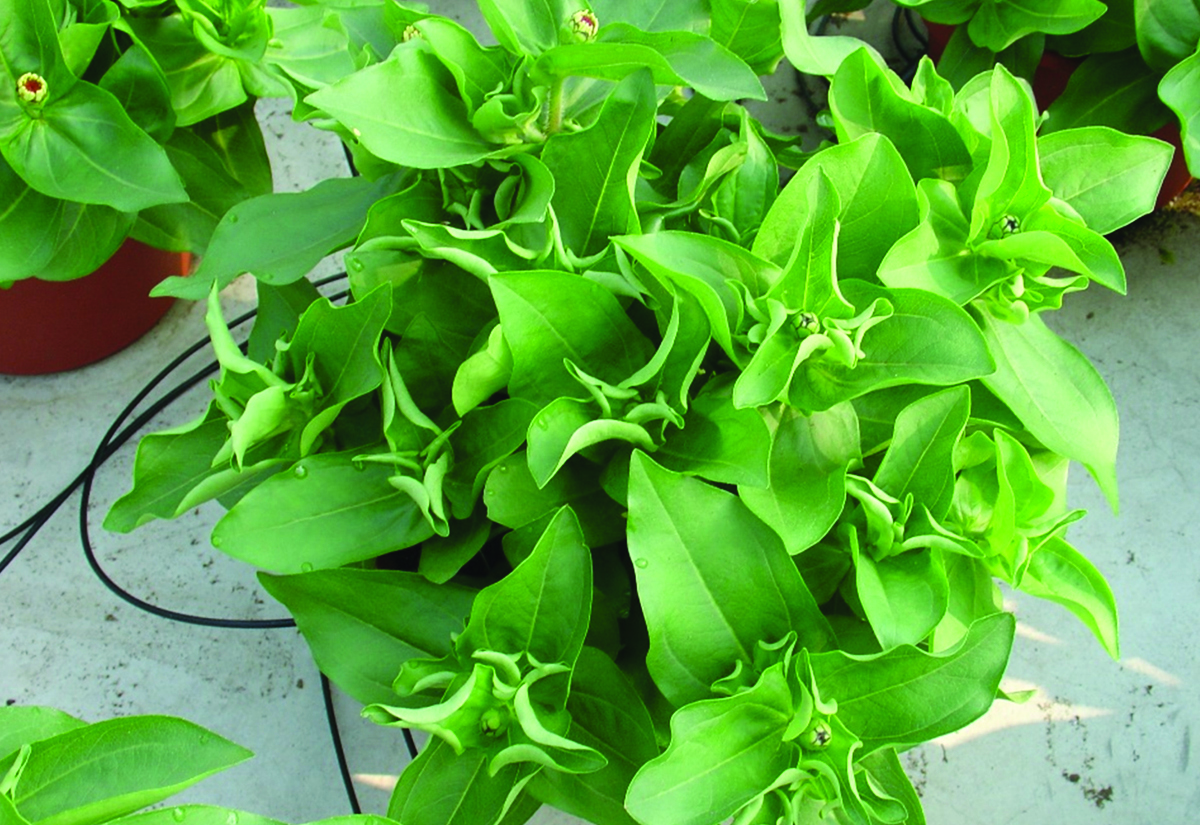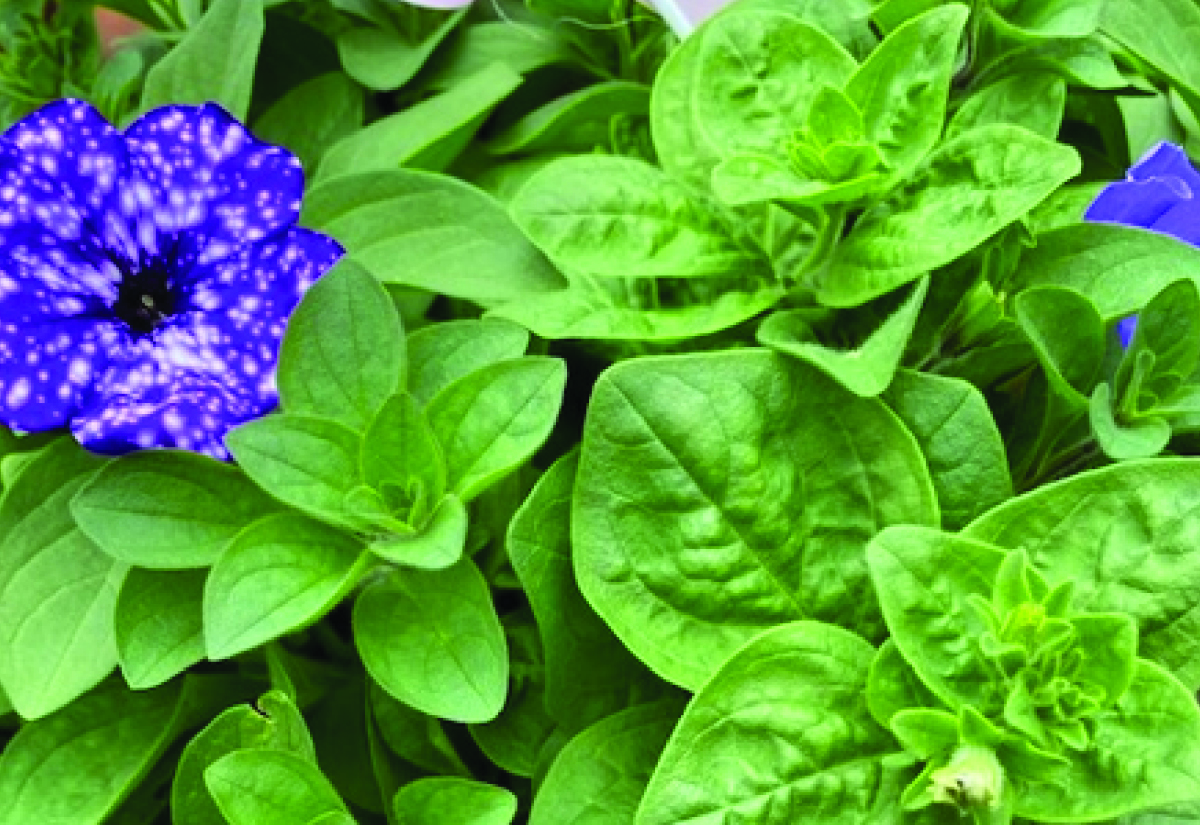Background & Importance
Calcium (Ca) – we often speak about the importance of calcium, but it also often gets pushed to the side as a “value-added nutrient”. The reality is that calcium is considered a secondary macronutrient for a reason, and in times of poor weather we see exactly why. Calcium provides structural support to plants as they develop, strengthening cell walls as new tissue grows. Without calcium, optimal foliage and flower development can be altered and even prevented. Plants lacking in calcium can display symptoms such as tip burn (necrosis) on new growth or pronounced leaf curl and puckering (Figures 1 & 2). For our edible growers, calcium deficiency even manifests as damage to developing fruits causing malformations and decreased yields.

Figure 1: Zinnia leaf curl due to Ca deficiency.

Figure 2: Petunia leaf puckering due to Ca deficiency.
Calcium deficiencies rear their head during poor growing conditions such as low light, cooler temperatures, and high relative humidity, because calcium uptake is heavily tied to plant transpiration. Plants take up nutrients from root system and transport them to newly developing areas of the plant using the plant’s ability to release water to the environment when trying to cool itself (i.e., “evapotranspiration”). When the process of transpiration is slowed or even ceased during poor weather conditions, calcium uptake is also negatively influenced. Propagation environments, early spring, and late fall are times where calcium deficiencies are most common. Altering the environment and providing ample amounts of calcium from fertilizer sources are key to preventing and correcting this deficiency.
Prevention & Correction
Did you ever wonder why some calcium nitrate-based fertilizers are called “Dark Weather” feeds? As highlighted above, poor weather and a lack of calcium uptake are directly correlated, so it is important to utilize high calcium containing fertilizer sources such as 15-0-15 during spans of cold, rainy, or cloudy weather. Although very popular, the use of “complete fertilizers” (i.e., fertilizers that contain both N, P, K, Ca, Mg, and micronutrients) alone may not provide enough calcium when extreme deficiencies are present. It is important to note that repeated use of high calcium nitrate containing fertilizers such as 15-0-15 and 15-0-0 can increase growing substrate pH, leading to micronutrient deficiencies especially in acid loving crops (e.g., petunia, calibrachoa, pansy). Growers can manage both calcium and micronutrient issues by rotating fertilizers between acid (e.g., 20-10-20, 21-5-20) and basic (e.g., 15-0-15) forming fertilizers. Talk to your Griffin sales representative to find out how GGSPro can help develop a fertilizer strategy based on your water quality and crop needs.
An additional option is selecting specialized calcium supplements without altering your fertilizer program. Foliar sprays have been proven to be an effective means of providing Ca to actively growing areas of the plant where calcium is needed most. Calcium chloride dihydrate (as compared to calcium nitrate) is the preferred calcium source for this purpose as it supplies readily available calcium without also adding nitrogen. It also contains no dye and leaves only a slight residue when used with a surfactant, such as CapSil. Foliar sprays of calcium fortify stems and minimize the risk of developing tip edge burn.
Foliar sprays of calcium chloride dihydrate at 0.5 oz per 3 gal of water (1 lb per 100 gal), along with 1/2 tsp per gal (8 oz per 100 gal) of CapSil as a spreading agent is a good starting point for correcting calcium deficiencies in most crops. Some sensitive blooming crops such as poinsettia and hydrangea should receive lower rates of CapSil when making foliar sprays (e.g., 4 oz per 100 gal). Repeating applications at 7 day intervals can be beneficial during times of low plant transpiration – slower drying conditions also aid in calcium absorption into the leaf or flower tissue. As with other foliar spray applications, never spray when the plants are under water stress or when greenhouse temperatures exceed 80 °F.
Culturally, improving the growing environment can also help prevent and alleviate calcium disorders. When evaluating available infrastructure tools, consider the use of supplemental lighting, horizontal air-flow (HAF) fans, and utilizing heat to increase light intensity, reduce relative humidity in the canopy, and boost air temperatures, respectively. Griffin’s Construction Department is here to discuss any enhancements you seek to maintain an optimal growing environment throughout the entire growing season.
Note, not all products are registered in all states. Some pesticides are restricted use in some states or regions and not others. It is the responsibility of the applicator to read and follow all label directions, remembering that labels may change. Other products may be safe and effective. Rates, application methods, and edible status are detailed in our GGSPro Insecticide & Fungicide Guides. Griffin also offers the 5th Edition GGSPro Technical Reference Guide in both English and now Spanish versions. This valuable resource outlines a wide range of pest control options and information on pollinator safety, BCA’s, scouting, weed management, plant lighting, nutrition, water quality and more!
Calcium (Ca) – we often speak about the importance of calcium, but it also often gets pushed to the side as a “value-added nutrient”. The reality is that calcium is considered a secondary macronutrient for a reason, and in times of poor weather we see exactly why. Calcium provides structural support to plants as they develop, strengthening cell walls as new tissue grows. Without calcium, optimal foliage and flower development can be altered and even prevented. Plants lacking in calcium can display symptoms such as tip burn (necrosis) on new growth or pronounced leaf curl and puckering (Figures 1 & 2). For our edible growers, calcium deficiency even manifests as damage to developing fruits causing malformations and decreased yields.

Figure 1: Zinnia leaf curl due to Ca deficiency.

Figure 2: Petunia leaf puckering due to Ca deficiency.
Calcium deficiencies rear their head during poor growing conditions such as low light, cooler temperatures, and high relative humidity, because calcium uptake is heavily tied to plant transpiration. Plants take up nutrients from root system and transport them to newly developing areas of the plant using the plant’s ability to release water to the environment when trying to cool itself (i.e., “evapotranspiration”). When the process of transpiration is slowed or even ceased during poor weather conditions, calcium uptake is also negatively influenced. Propagation environments, early spring, and late fall are times where calcium deficiencies are most common. Altering the environment and providing ample amounts of calcium from fertilizer sources are key to preventing and correcting this deficiency.
Prevention & Correction
Did you ever wonder why some calcium nitrate-based fertilizers are called “Dark Weather” feeds? As highlighted above, poor weather and a lack of calcium uptake are directly correlated, so it is important to utilize high calcium containing fertilizer sources such as 15-0-15 during spans of cold, rainy, or cloudy weather. Although very popular, the use of “complete fertilizers” (i.e., fertilizers that contain both N, P, K, Ca, Mg, and micronutrients) alone may not provide enough calcium when extreme deficiencies are present. It is important to note that repeated use of high calcium nitrate containing fertilizers such as 15-0-15 and 15-0-0 can increase growing substrate pH, leading to micronutrient deficiencies especially in acid loving crops (e.g., petunia, calibrachoa, pansy). Growers can manage both calcium and micronutrient issues by rotating fertilizers between acid (e.g., 20-10-20, 21-5-20) and basic (e.g., 15-0-15) forming fertilizers. Talk to your Griffin sales representative to find out how GGSPro can help develop a fertilizer strategy based on your water quality and crop needs.
An additional option is selecting specialized calcium supplements without altering your fertilizer program. Foliar sprays have been proven to be an effective means of providing Ca to actively growing areas of the plant where calcium is needed most. Calcium chloride dihydrate (as compared to calcium nitrate) is the preferred calcium source for this purpose as it supplies readily available calcium without also adding nitrogen. It also contains no dye and leaves only a slight residue when used with a surfactant, such as CapSil. Foliar sprays of calcium fortify stems and minimize the risk of developing tip edge burn.
Foliar sprays of calcium chloride dihydrate at 0.5 oz per 3 gal of water (1 lb per 100 gal), along with 1/2 tsp per gal (8 oz per 100 gal) of CapSil as a spreading agent is a good starting point for correcting calcium deficiencies in most crops. Some sensitive blooming crops such as poinsettia and hydrangea should receive lower rates of CapSil when making foliar sprays (e.g., 4 oz per 100 gal). Repeating applications at 7 day intervals can be beneficial during times of low plant transpiration – slower drying conditions also aid in calcium absorption into the leaf or flower tissue. As with other foliar spray applications, never spray when the plants are under water stress or when greenhouse temperatures exceed 80 °F.
Culturally, improving the growing environment can also help prevent and alleviate calcium disorders. When evaluating available infrastructure tools, consider the use of supplemental lighting, horizontal air-flow (HAF) fans, and utilizing heat to increase light intensity, reduce relative humidity in the canopy, and boost air temperatures, respectively. Griffin’s Construction Department is here to discuss any enhancements you seek to maintain an optimal growing environment throughout the entire growing season.
| Item Description | Item Number |
|---|---|
| Peters Professional Peat-Lite 15-0-15 | 67-2340 |
| Jack’s Dark Weather Peat-Lite 15-0-15 | 33627 |
| Plantex 15-0-15 Cal-Plus | 31-140100 |
| Jack’s Calcium Chloride Dihydrate | 1 lb – 35315; 25 lb – 35317 |
| Yara Calcinit Calcium Nitrate | 67-8130 |
| Plantex Calcium Nitrate | 31-10033 |
Note, not all products are registered in all states. Some pesticides are restricted use in some states or regions and not others. It is the responsibility of the applicator to read and follow all label directions, remembering that labels may change. Other products may be safe and effective. Rates, application methods, and edible status are detailed in our GGSPro Insecticide & Fungicide Guides. Griffin also offers the 5th Edition GGSPro Technical Reference Guide in both English and now Spanish versions. This valuable resource outlines a wide range of pest control options and information on pollinator safety, BCA’s, scouting, weed management, plant lighting, nutrition, water quality and more!